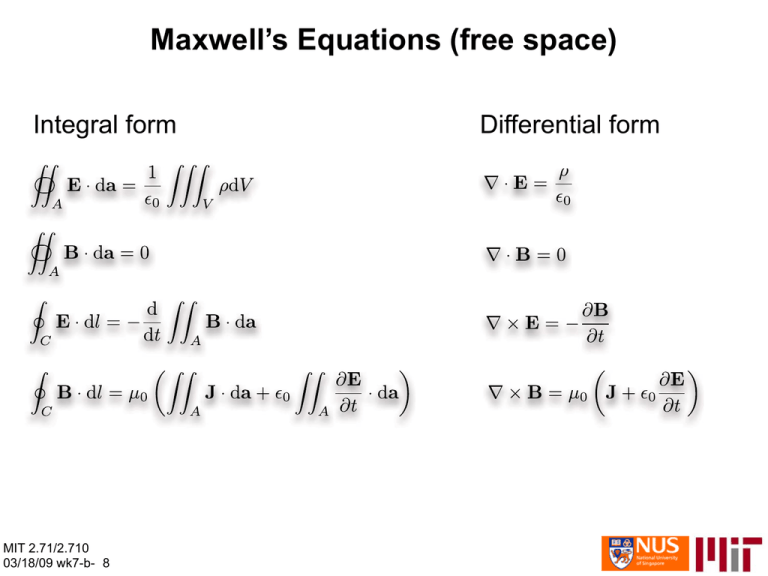
Maxwell’s Equations (free space)
Integral form
MIT 2.71/2.710
03/18/09 wk7-b- 8
Differential form
Wave Equation for electromagnetic waves
MIT 2.71/2.710
03/18/09 wk7-b- 9
Electric fields in matter
atom under electric field:
• charge neutrality is preserved
• spatial distribution of charges
becomes assymetric
Dipole moment
Polarization
Spatially variant polarization
induces local charge imbalances
(bound charges)
MIT 2.71/2.710
03/18/09 wk7-b-10
Fig. 3.38 in Hecht, Eugene. Optics. Reading, MA: Addison-Wesley, 2001.
ISBN: 9780805385663. (c) Addison-Wesley. All rights reserved. This content
is excluded from our Creative Commons license. For more information,
see http://ocw.mit.edu/fairuse.
Constitutive relationships
E: electric field
D: electric displacement
polarization
“Spring” binding the
electron to the nucleus
is linear: i.e., electron
displacement as
function of electric force
is given by Hooke’s law
with spring constant
B: magnetic induction
H: magnetic field
magnetization
Most optical materials are non magnetic at optical frequencies,
i.e. M=0; therefore, B=μ0
MIT 2.71/2.710
03/18/09 wk7-b- 11
Fig. 3.38 in Hecht, Eugene. Optics. Reading, MA: Addison-Wesley, 2001.
ISBN: 9780805385663. (c) Addison-Wesley. All rights reserved. This content
is excluded from our Creative Commons license. For more information,
see http://ocw.mit.edu/fairuse.
Maxwell’s equations in constitutive form
Vacuum
Matter with free
charges and currents
Matter without free
charges or currents
Wave equation in matter but without free charges or currents becomes:
MIT 2.71/2.710
03/18/09 wk7-b-12
k, E, B form a right-handed triad
.
In free space or isotropic media,
the vectors k, E, B form a
right-handed triad.
MIT 2.71/2.710
03/18/09 wk7-b-13
Fig. 3.13, 3.14 in Hecht, Eugene. Optics. Reading, MA: Addison-Wesley, 2001.
ISBN: 9780805385663. (c) Addison-Wesley. All rights reserved. This content
is excluded from ourCreative Commons license. For more information,
see http://ocw.mit.edu/fairuse.
The Poynting vector
E
S
㱻
In the case of harmonic waves,
B
E
k
B
MIT 2.71/2.710
03/18/09 wk7-b-14
㱺
Irradiance (aka Intensity)
From the definition of the Poynting vector and the k, E, B relationship,
For a harmonic (sinusoidal) wave propagating along z
Recall at optical frequencies, the field oscillates very rapidly, ~10141015 Hz.
Therefore, opto-electronic detectors only register the average energy flux
This referred to as irradiance or intensity of the optical field,
and is measured in units of W/m2 (more commonly W/cm2)
(T=2/ or integral multiples)
Since
MIT 2.71/2.710
03/18/09 wk7-b-15
for the harmonic wave the intensity is
Calculation of the intensity from phasors
Recall the phasor representation of a harmonic wave
We cannot quite represent the Poynting vector as a phasor, because the Poynting vector is
obtained as a product of the E, B fields (recall we may only add or subtract phasors; we are
not allowed to do nonlinear operations with them.)
Nevertheless, we can obtain the intensity (time-averaged Poynting vector) from the phasor
as follows:
Consider the time-averaged superposition of
two fields at the same frequency:
Now consider the corresponding
phasors:
and form the quantity
Clearly,
MIT 2.71/2.710
03/18/09 wk7-b-16
MIT OpenCourseWare
http://ocw.mit.edu
2.71 / 2.710 Optics
Spring 2009
For information about citing these materials or our Terms of Use, visit: http://ocw.mit.edu/terms.

